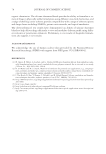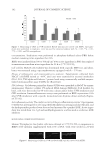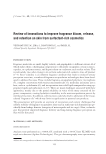J. Cosmet. Sci., 68, 42–47 ( January/February 2017) 42 Designing new functional cosmetic ingredients from polyglycerol, a versatile bio-based platform for improved sustainability MICHAEL J. FEVOLA, FRANK C. SUN, and STACEY E. YORK, Johnson & Johnson Consumer Inc., Skillman, NJ 08558 (M.J.F., F.C.S.) and University of Oregon, Eugene, OR 97403 (S.E.Y.). Synopsis Polyglycerol (PG) is a well-known cosmetic ingredient and important precursor for the synthesis of a variety of cosmetic ingredients, such as surfactants, emulsifi ers, and conditioning agents for hair and skin. When derived from renewable resources, PG can provide a more sustainable platform for the development of new ingredients with improved performance in cosmetic applications. This paper will discuss recent advances in the utilization of bio-based PG ingredients as alternatives to traditional ethoxylate chemistries for mild nonionic surfactants, substantive humectants, and micellar thickeners. INTRODUCTION: POLYGLYCEROL AS A BIO-BASED CHEMICAL PLATFORM In addition to being one of the most widely used cosmetic ingredients, glycerin also serves as a feedstock for the synthesis of a variety of surfactants, emulsifi ers, conditioning agents, and other cosmetic ingredients (1). Plant-derived glycerin is an abundant bio-based coprod- uct resulting from the oleochemical production of fatty acids and soap it is the preferred source of glycerin for cosmetics, and it is an attractive platform for the development of new cosmetic ingredients with improved functionalities. Polyglycerol (PG) is a complex, polydisperse, low molecular weight polyether composed of repeat units that are based on dehydrated three-carbon glycerol groups, which can be linear, branched, or cyclic in nature (2). PG is extremely hydrophilic due to the presence of many pendant hydroxyl groups in primary and secondary positions however, the hy- droxyl values and hydrophilicity of PG decreases with increasing cyclic repeat unit con- tent, as each cyclic repeat unit formed effectively consumes one pendant hydroxyl group. Bio-based PG may be produced via the direct condensation polymerization of glycerol (purifi ed glycerin) with water as the by-product, or via ring-opening polymerization of glyceryl carbonate (GC), a cyclic carbonate monomer synthesized from glycerol (Figure 1). Other routes to PG exist, e.g., via polymerization of glycidol or epichlorohydrin however, these routes are less preferred, since most glycidol and epichlorohydrin are derived from nonre- newable feedstocks, and these monomers present signifi cant health and safety hazards. Address all correspondence to Michael Fevola at mfevola@its.jnj.com.
NEW COSMETIC INGREDIENTS FROM POLYGLYCEROL 43 Although PG has been known for over a century, this material offers a plurality of benefi ts that continue to make it a practical platform for the development of cosmetic ingredients. PG is nontoxic and biodegradable, and polyglyceryl esters (PGEs) have been safely used as ingredients in food and cosmetics for several decades. The extreme hydrophilicity of PG renders it highly biocompatible and makes PG a good candidate for the synthesis of hydrophilic moieties in nonionic amphiphilic molecules. PG is especially attractive as an alternative to traditional polyethylene glycol (PEG) chem- istry. While the majority of PEG is derived from nonrenewable feedstocks (e.g., natural gas), PG is 100% renewable when derived from bio-based glycerol. PG does not contain or give rise to 1,4-dioxane, a controversial trace by-product that has led to a negative public perception of PEG-based ingredients (despite the fact that they are recognized as safe by regulatory agencies and independent scientifi c panels). PG is signifi cantly more hydrophilic than PEG due to its higher hydroxyl values at equivalent molecular weights, and it is more amenable to chemical modifi cation compared to PEG due to its greater number of free hy- droxyl groups as sites for substitution. Figure 1 demonstrates various synthetic routes that can be employed when using PG as a synthetic platform this versatility enables PG to be derivatized in a variety of ways to achieve specifi c functional benefi ts. HIGH HLB PGEs AS ALTERNATIVES TO ETHOXYLATED SORBITAN ESTERS IN MILD CLEANSERS Highly ethoxylated sorbitan esters, e.g., PEG-80 sorbitan laurate and polysorbate 20, have traditionally been utilized to enhance the mildness of gentle cleansing products, such as baby shampoos and adult facial cleansers (3,4). Recently, high HLB polyglyceryl nonionic surfactants, in particular PGEs, have received renewed attention as ethoxylate alternatives for this application and have proven successful at delivering mildness with- out compromising on performance (5). Table I shows examples of such surfactant blends based on a combination of polyglyceryl-10 oleate, polyglyceryl-10 laurate, zwitterionic surfactants, and sulfate-free anionic surfactants Figure 1. Synthetic versatility of PG chemistry as a platform for cosmetic ingredients.
Purchased for the exclusive use of nofirst nolast (unknown) From: SCC Media Library & Resource Center (library.scconline.org)












































































































































